
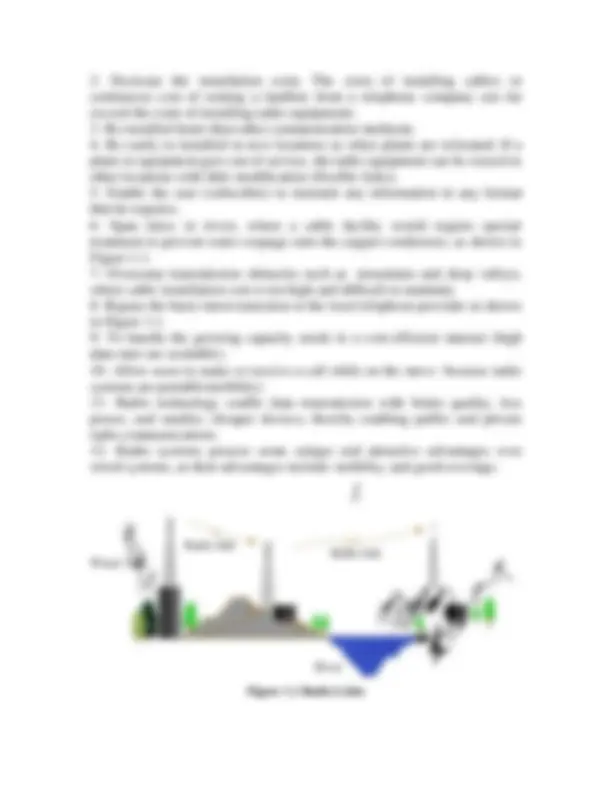
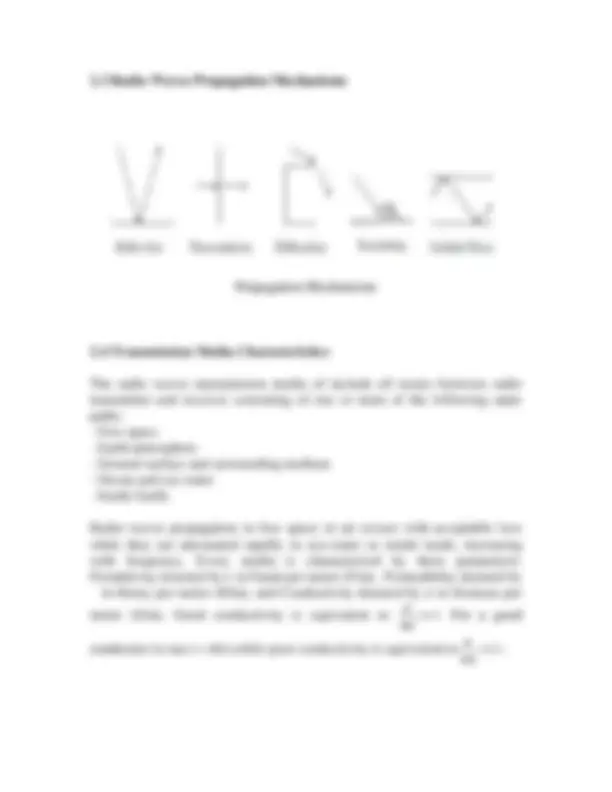
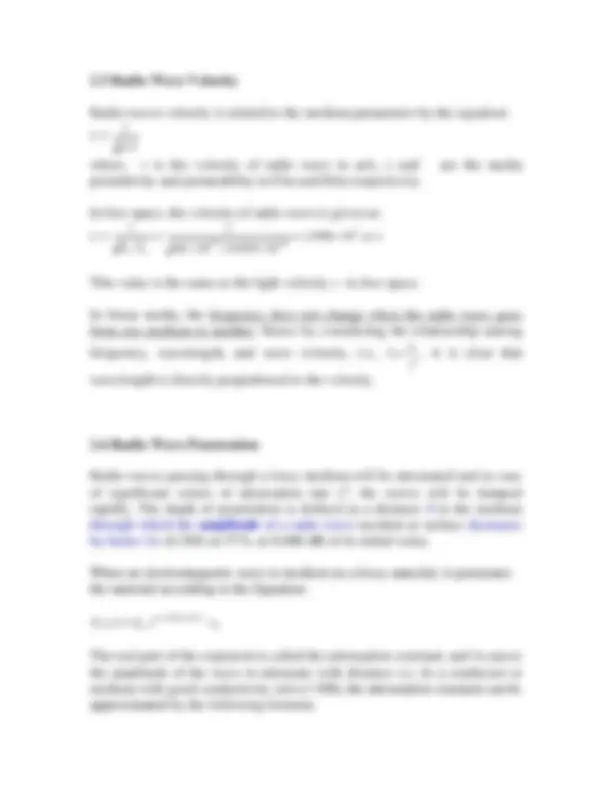
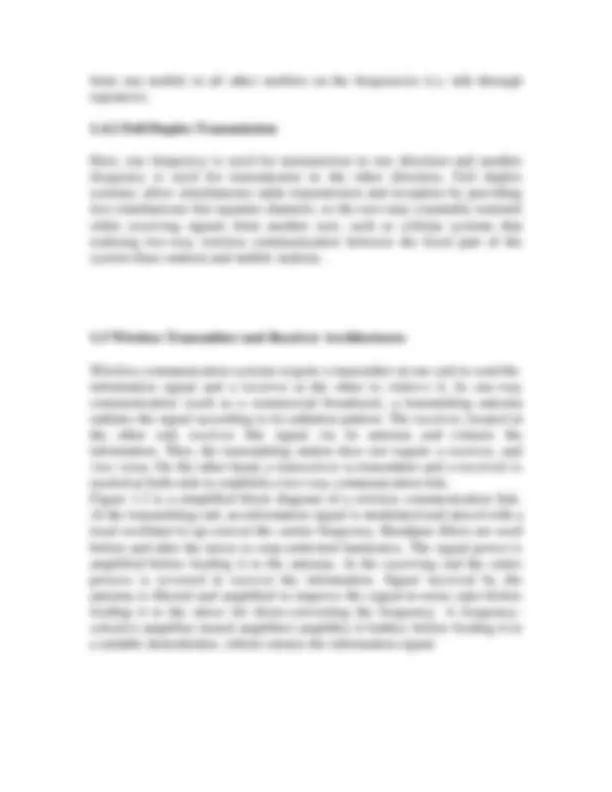
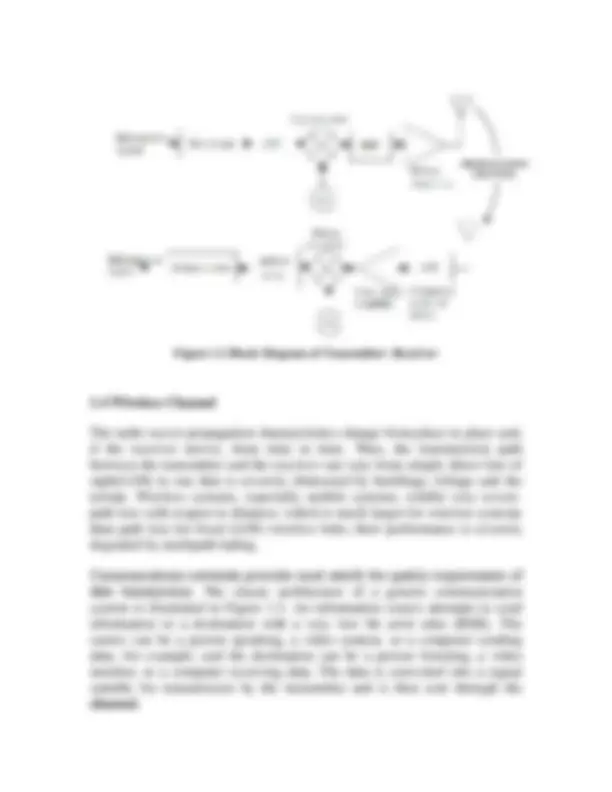
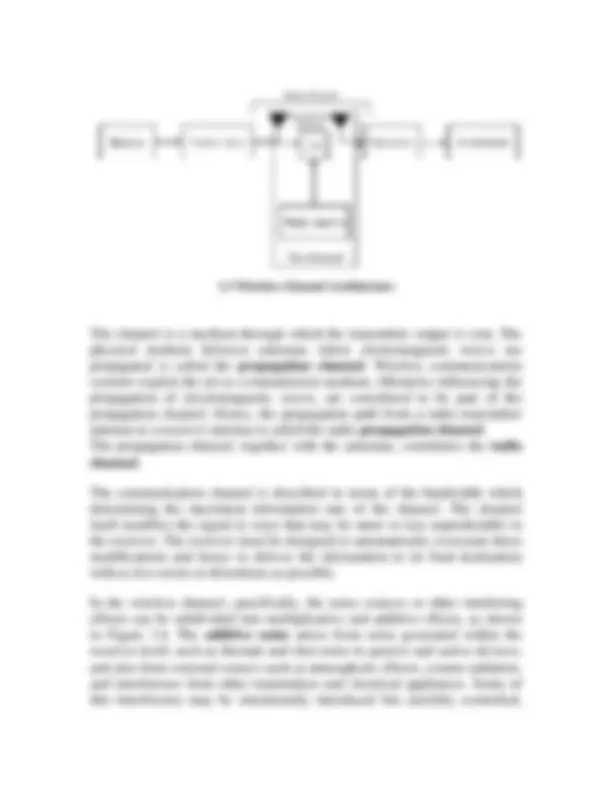
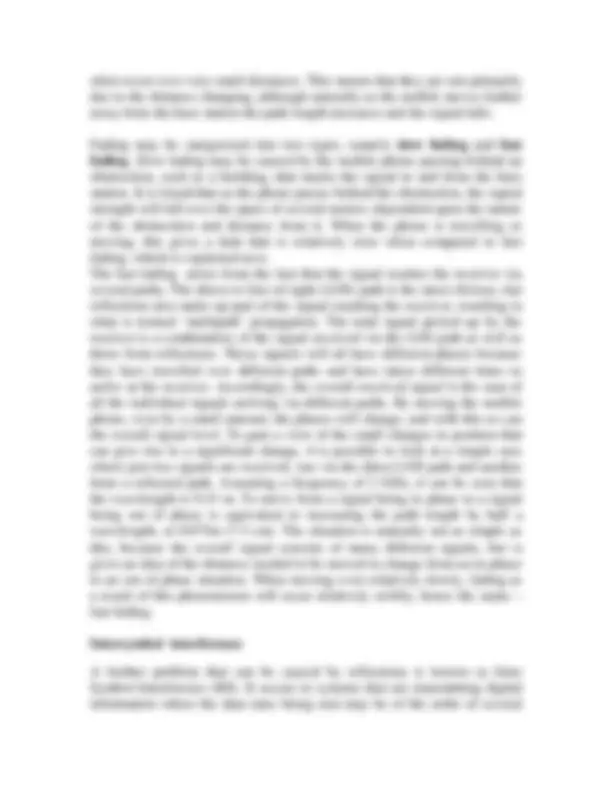
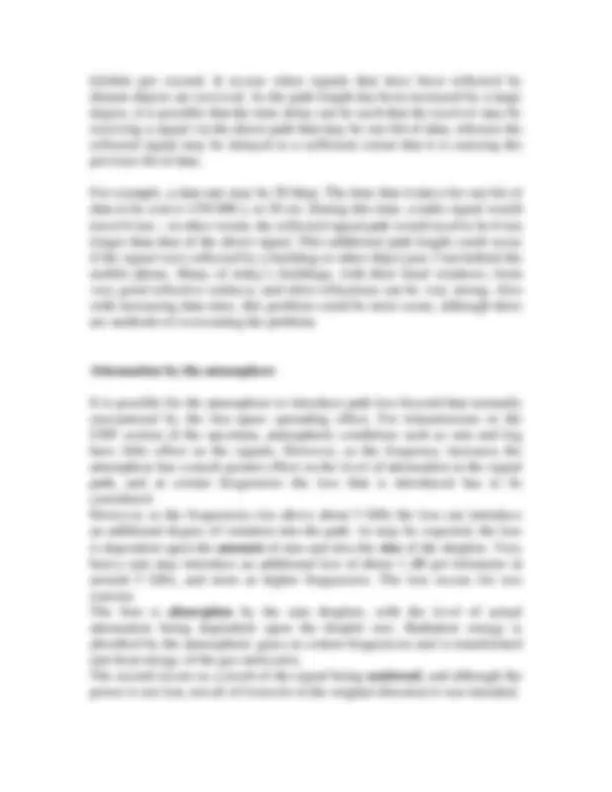



Study with the several resources on Docsity

Earn points by helping other students or get them with a premium plan


Prepare for your exams
Study with the several resources on Docsity

Earn points to download
Earn points by helping other students or get them with a premium plan
Community
Ask the community for help and clear up your study doubts
Discover the best universities in your country according to Docsity users
Free resources
Download our free guides on studying techniques, anxiety management strategies, and thesis advice from Docsity tutors
The four basic media for information transfer in communication systems: copper cables, optical fiber cables, radio waves, and free-space optics. It compares the advantages and disadvantages of wired and wireless networks, focusing on radio waves as a communication medium. the propagation of radio waves in different media, their velocity, and the attenuation constant and skin depth. It also mentions the classification of radio transmission systems and their architectures.
Typology: Study notes
1 / 15

This page cannot be seen from the preview
Don't miss anything!










2.1 Data Transmission Transmission is the process of transporting information between end points of a system or a network. Transmission systems use four basic media for information transfer from one point to another:
2. 3 Radio Waves Propagation Mechanisms Propagation Mechanisms 2. 4 Transmission Media Characteristics The radio waves transmission media of include all routes between radio transmitter and receiver consisting of one or more of the following main paths:
2. 5 Radio Wave Velocity Radio waves velocity is related to the medium parameters by the equation: 1 where, v is the velocity of radio wave in m/s, ε and μ are the media permittivity and permeability in F/m and H/m respectively. In free space, the velocity of radio wave is given as: 2. 998 10 m / s 4 10 8. 854 10 (^1 ) 7 12 This value is the same as the light velocity c in free space. In linear media, the frequency does not change when the radio wave goes from one medium to another. Hence by considering the relationship among frequency, wavelength, and wave velocity, i.e., f , it is clear that wavelength is directly proportional to the velocity. 2. 6 Radio Wave Penetration Radio waves passing through a lossy medium will be attenuated and in case of significant values of attenuation rate e α , the waves will be damped rapidly. The depth of penetration is defined as a distance δ in the medium through which the amplitude of a radio wave incident at surface decreases by factor 1/ e (0.368) or 37%, or 8.686 dB of its initial value. When an electromagnetic wave is incident on a lossy material, it penetrates the material according to the Equation: x z j t z E (^) x z E e a ( ) ( ) The real part of the exponent is called the attenuation constant, and it causes the amplitude of the wave to attenuate with distance ( z ). In a conductor or medium with good conductivity ( σ/ωε> 100), the attenuation constant can be approximated by the following formula:
_1. Why earth attenuate radio waves severely? Why this mode of propagation is useful for frequencies below 30 MHz. What are factors controlling surface ground wave propagation?
from one mobile to all other mobiles on the frequencies (i.e. talk through repeaters). 1.4.2 Full Duplex Transmission Here, one frequency is used for transmission in one direction and another frequency is used for transmission in the other direction. Full duplex systems; allow simultaneous radio transmission and reception by providing two simultaneous but separate channels, so the user may constantly transmit while receiving signals from another user, such as cellular systems that realizing two-way wireless communication between the fixed part of the system (base station) and mobile stations. 1.5 Wireless Transmitter and Receiver Architectures Wireless communication systems require a transmitter at one end to send the information signal and a receiver at the other to retrieve it. In one-way communication (such as a commercial broadcast), a transmitting antenna radiates the signal according to its radiation pattern. The receiver, located at the other end, receives this signal via its antenna and extracts the information. Thus, the transmitting station does not require a receiver, and vice versa. On the other hand, a transceiver (a transmitter and a receiver) is needed at both ends to establish a two-way communication link. Figure 1.2 is a simplified block diagram of a wireless communication link. At the transmitting end, an information signal is modulated and mixed with a local oscillator to up-convert the carrier frequency. Bandpass filters are used before and after the mixer to stop undesired harmonics. The signal power is amplified before feeding it to the antenna. At the receiving end the entire process is reversed to recover the information. Signal received by the antenna is filtered and amplified to improve the signal-to-noise ratio before feeding it to the mixer for down-converting the frequency. A frequency- selective amplifier (tuned amplifier) amplifies it further, before feeding it to a suitable demodulator, which extracts the information signal.
1.3 Wireless Channel Architecture The channel is a medium through which the transmitter output is sent. The physical medium between antennas where electromagnetic waves are propagated is called the propagation channel. Wireless communications systems exploit the air as a transmission medium. Obstacles influencing the propagation of electromagnetic waves, are considered to be part of the propagation channel. Hence, the propagation path from a radio transmitter antenna to a receiver antenna is called the radio propagation channel. The propagation channel, together with the antennas, constitutes the radio channel. The communication channel is described in terms of the bandwidth which determining the maximum information rate of the channel. The channel itself modifies the signal in ways that may be more or less unpredictable to the receiver. The receiver must be designed to automatically overcome these modifications and hence to deliver the information to its final destination with as few errors or distortions as possible. In the wireless channel, specifically, the noise sources or other interfering effects can be subdivided into multiplicative and additive effects, as shown in Figure 1.4. The additive noise arises from noise generated within the receiver itself, such as thermal and shot noise in passive and active devices, and also from external sources such as atmospheric effects, cosmic radiation, and interference from other transmitters and electrical appliances. Some of this interference may be intentionally introduced but carefully controlled, Propagation Channel Radio Channel
such as when channels are reused in order to maximize the capacity of a cellular radio system. The multiplicative noise arises from the various communication processes encountered by transmitted waves on their way from the transmitter antenna to the receiver antenna, such as:
often occur over very small distances. This means that they are not primarily due to the distance changing, although naturally as the mobile moves further away from the base station the path length increases and the signal falls. Fading may be categorized into two types, namely slow fading and fast fading. Slow fading may be caused by the mobile phone passing behind an obstruction, such as a building, that masks the signal to and from the base station. It is found that as the phone passes behind the obstruction, the signal strength will fall over the space of several meters, dependent upon the nature of the obstruction and distance from it. When the phone is travelling or moving, this gives a fade that is relatively slow when compared to fast fading, which is explained next. The fast fading arises from the fact that the signal reaches the receiver via several paths. The direct or line-of-sight (LOS) path is the most obvious, but reflections also make up part of the signal reaching the receiver, resulting in what is termed ‘multipath’ propagation. The total signal picked up by the receiver is a combination of the signal received via the LOS path as well as those from reflections. These signals will all have different phases because they have travelled over different paths and have taken different times to arrive at the receiver. Accordingly, the overall received signal is the sum of all the individual signals arriving via different paths. By moving the mobile phone, even by a small amount, the phases will change, and with this so can the overall signal level. To gain a view of the small changes in position that can give rise to a significant change, it is possible to look at a simple case where just two signals are received, one via the direct LOS path and another from a reflected path. Assuming a frequency of 2 GHz, it can be seen that the wavelength is 0.15 m. To move from a signal being in phase to a signal being out of phase is equivalent to increasing the path length by half a wavelength, or 0.075m (7.5 cm). The situation is naturally not as simple as this, because the overall signal consists of many different signals, but is gives an idea of the distance needed to be moved to change from an in-phase to an out of phase situation. When moving even relatively slowly, fading as a result of this phenomenon will occur relatively swiftly, hence the name – fast fading. Intersymbol interference A further problem that can be caused by reflections is known as Inter Symbol Interference (ISI). It occurs in systems that are transmitting digital information where the data rates being sent may be of the order of several
kilobits per second. It occurs when signals that have been reflected by distant objects are received. As the path length has been increased by a large degree, it is possible that the time delay can be such that the receiver may be receiving a signal via the direct path that may be one bit of data, whereas the reflected signal may be delayed to a sufficient extent that it is carrying the previous bit of data. For example, a data rate may be 50 kbps. The time that it takes for one bit of data to be sent is 1/50 000 s, or 20 m s. During this time, a radio signal would travel 6 km – in other words, the reflected signal path would need to be 6 km longer than that of the direct signal. This additional path length could occur if the signal were reflected by a building or other object just 3 km behind the mobile phone. Many of today’s buildings, with their lined windows, form very good reflective surfaces, and often reflections can be very strong. Also with increasing data rates, this problem could be more acute, although there are methods of overcoming the problem. Attenuation by the atmosphere It is possible for the atmosphere to introduce path loss beyond that normally encountered by the free-space spreading effect. For transmissions in the UHF section of the spectrum, atmospheric conditions such as rain and fog have little effect on the signals. However, as the frequency increases the atmosphere has a much greater effect on the level of attenuation in the signal path, and at certain frequencies the loss that is introduced has to be considered. However, as the frequencies rise above about 3 GHz the loss can introduce an additional degree of variation into the path. As may be expected, the loss is dependent upon the amount of rain and also the size of the droplets. Very heavy rain may introduce an additional loss of about 1 dB per kilometer at around 5 GHz, and more at higher frequencies. The loss occurs for two reasons. The first is absorption by the rain droplets, with the level of actual attenuation being dependent upon the droplet size. Radiation energy is absorbed by the atmospheric gases at certain frequencies and is transformed into heat energy of the gas molecules. The second occurs as a result of the signal being scattered , and although the power is not lost, not all of it travels in the original direction it was intended.